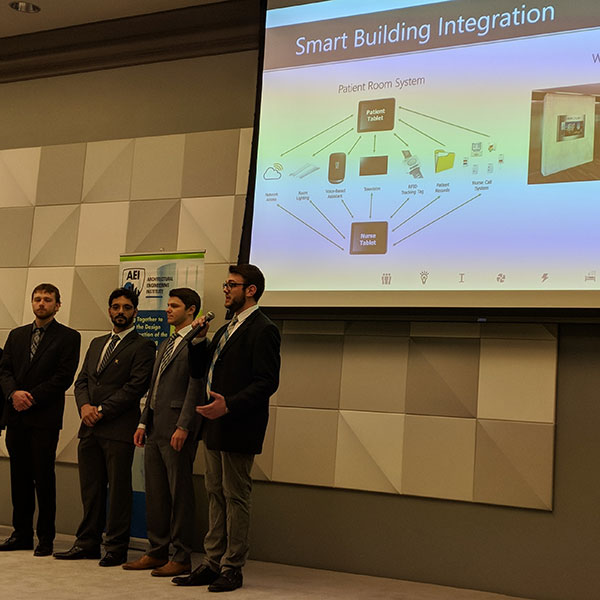Calendar Icon
May 03, 2018
Person Bust Icon
By Karl Vogel
![]() RSS
Submit a Story
RSS
Submit a Story

Academic programs in the College of Engineering have found success including senior design projects as capstones to the undergraduate experience. Nebraska’s unique architectural engineering degree program is providing extra value via its four-plus-one structure.
Instead of having students on a four-year or five-year track to earn a bachelor’s degree, the AE program results in nearly all of its students receiving a master’s degree after a fifth year of study. Students can receive an unaccredited bachelor’s degree and opt out of the master’s program.
Clarence Waters, professor of architectural engineering and industry liaison, came to Nebraska in 2000 and is one of the primary shapers of the fledgling program. Waters said the four-plus-one was created to help Nebraska stand out among its AE peers, but has also raised expectations for and performance within the program.
“Historically, the best architectural engineering programs in the country came out of more of an architecture tradition. They were five-year bachelor’s degrees. We wanted to compete with the very best programs in the country,” Waters said.
“Students can go (to another university) and get an accredited AE degree in four years, but here it’s five. We have to maintain that differential to show the students the extra year is worthwhile.”
In the fifth year, AE students are split into teams that prepare presentations for the annual Architectural Engineering Institute (AEI) Forum Student Design Competition. Students specialize in different areas: building integration, structural systems, mechanical systems, electrical systems and construction management and development.
In past years, universities could enter multiple teams and Nebraska students raked in multiple awards. That includes Nebraska taking home eight of the 12 awards presented in seven categories at the 2017 Forum. At the 2018 competition, held April 4-6 at Scott Conference Center in Omaha, the Nebraska teams earned two more awards – second place in both mechanical systems design and structural systems design.
To prepare for the competition, a group of nearly 100 alumni and professional engineers mentor the students and evaluate the proposals. Some, Waters said, are from Nebraska and others participate by traveling to Omaha or connecting with students via technology.
“We’re very, very fortunate to have so many mentors. Some of the mentors are putting in hundreds of hours, and that’s added value,” Waters said. “The first day of class I make the students calculate the contributions of industry to this class based on an hourly rate. At a rate of $125 an hour, the students are getting more than a quarter-million dollars worth of consultation from industry experts.”
The connection to the Nebraska AE program, Waters said, also benefits the industry partners and the students by creating network connections and employment opportunities.
For this year’s forum, schools could only submit one team’s proposal and only five universities were chosen to present.
This created competition among the three AE teams at The Durham School, Waters said.
“I think part of the success is that it raises the bar. Good students are attracted to that higher standard,” Waters said. “The whole thing comes together to form a perfect storm – we have high-caliber students, they’re master’s students, then the access to so much local industry and having great industry involvement and the competition.”
Submit a Story


